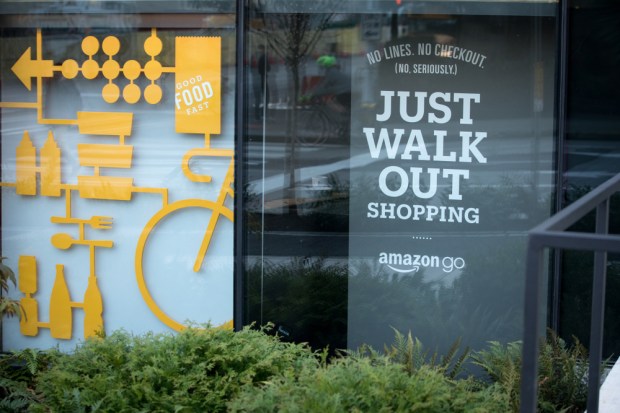Amazon’s Checkout-Free Retail Push Takes Aim at Walmart’s Brick-and-Mortar Dominance

In commerce, as in war, battles are seldom fought on one front alone.
So it is no surprise that the jousting between Walmart and Amazon occurs across physical and eCommerce channels. Amazon, for its part, has just signaled that it is stepping up efforts to gain a more significant beachhead in the brick-and-mortar space.
As reported this week, the company is expanding its Just Walk Out technology — a checkout-free shopping tool that initially targeted food and beverage sales — to now branch into apparel, offering more speedy transactions.
This technology adds radio-frequency identification (RFID) to the shopping experience. Customers can now grab the items they want to buy and walk out of the store through an exit gate — even while wearing their purchases. Customers pay by tapping their credit or debit card or hovering their palm over an Amazon One palm recognition device.
The Amazon announcement spotlights how it is bringing its technology into a broader retail ecosystem beyond the confines of an online platform.
At the moment, there is a lot of runway ahead. Amazon’s physical store revenue, mainly from Whole Foods Market, increased by 6.4% in Q2 2023 compared to Q2 2022. It increased by 2.6% compared to the previous quarter. Year over year, as of the end of 2022, the company had logged nearly $19 billion in physical store sales. This amount is just a sliver of the more than $100 billion in brick-and-mortar sales that Walmart logged last quarter. Walmart has a significantly higher share of food and beverage spend than Amazon.
Free? Of course.
You've uncovered one of our premium articles. Register to keep reading and receive free unlimited access to all our premium content.
But Amazon’s move to sell its cashier-less technology to other merchants to help reimagine in-store interactions conceivably gives more torque to its physical retail efforts.
Amazon, as is well known, has been retooling its grocery operations and will be highlighting updated stores. CEO Andy Jassy said during past earnings commentary, “If you really want to serve as much of grocery as we’d like to, you have to have a mass physical offering, and that’s what we’ve been working on for a few years with the brand we’ve called Amazon Fresh.”
However, the script switches a bit when considering apparel sales. As measured in the latest quarter, Walmart’s share of overall retail sales in that segment came in at 6.9%, trailing Amazon’s 15%+ share.
Amazon has also proven that it has been willing to take a bit of a haircut — a temporary one, to be sure — on some of its eCommerce sales in order to boost traffic.
In one example, during this summer’s Prime Day, Amazon offered members discounts on in-store purchases of groceries and fashion items. Members who spent $50 or more at Amazon Fresh stores would receive 25% off their in-store purchases during Prime Day. Prime Visa card members with an eligible Prime membership earned 6% back on Prime Day when they shopped at Amazon Fresh using that card. At Amazon Go stores, which offer a range of food, beverages and everyday essentials with no checkout lines, Prime members who spent $10 would get $5 back to spend on their next visit.